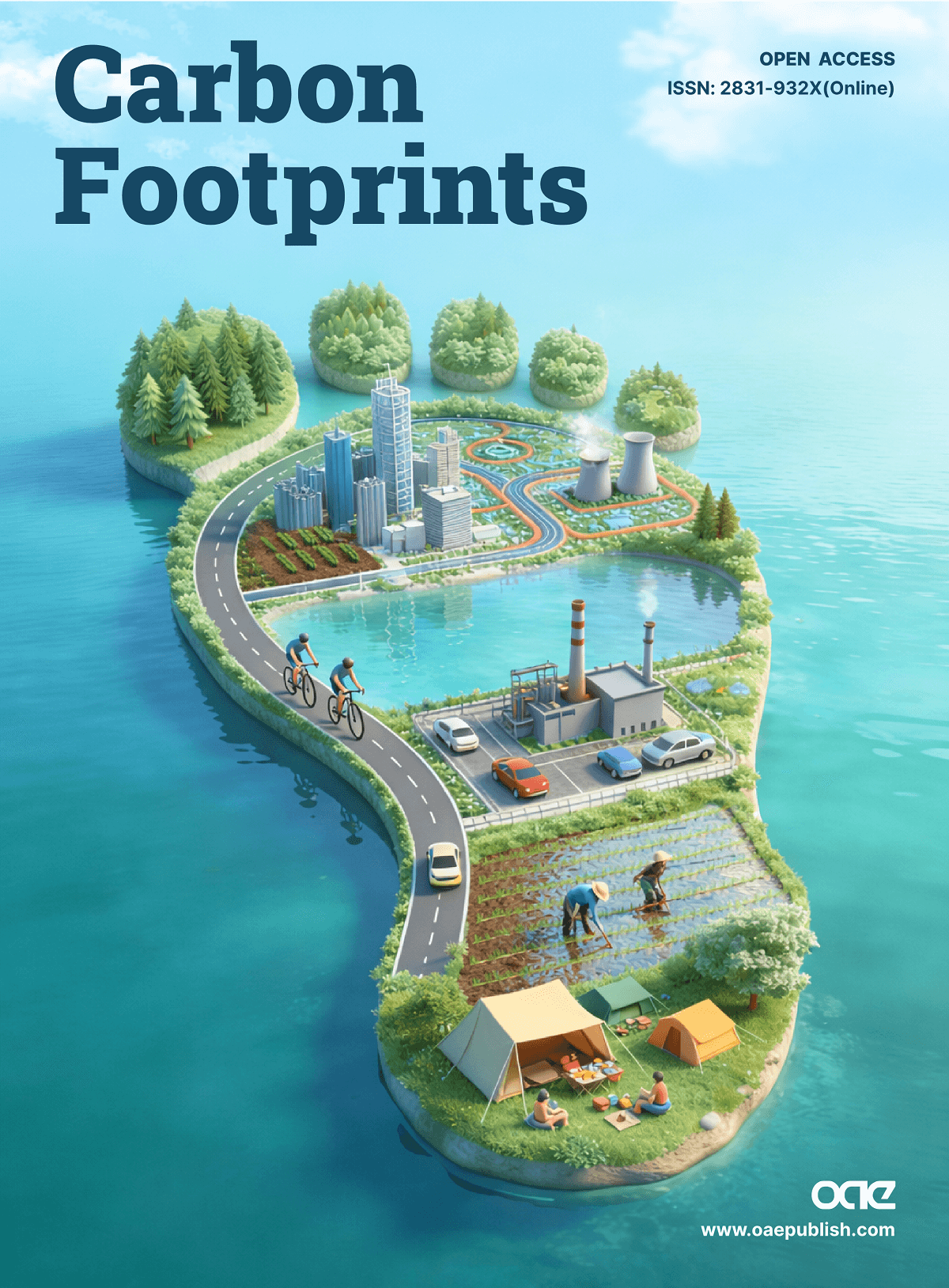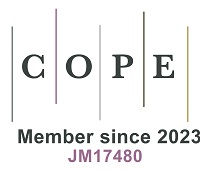Perspectives on carbon footprint of agricultural land-use in Brazil
Abstract
Brazil is one of the main producers in the agricultural and forestry sector worldwide, with production systems based on high consumption of inputs that contribute to high levels of greenhouse gas (GHG) emissions. This paper presents an analysis of the scenario of national GHG emissions and carbon footprints in the major production systems of agriculture, including livestock production and forestry, and the potential for soil carbon storage as a mitigation strategy under these systems. The main sources of national GHG emissions are beef cattle due to enteric fermentation and the management of agricultural soils through the use of nitrogen fertilizers. The increasing adoption of low-carbon agriculture has led to a reduction in the carbon footprint through no-till technologies, agrosilvopastoral systems, N2 fixation, and tree plantations. These technologies deserve to be increasingly disseminated to generate economic opportunities leading to financial gains from the commercialization of carbon credits and payment for environmental services.
Keywords
INTRODUCTION
Agriculture is practiced throughout the national territory of Brazil, covering six different biomes (Amazon, Cerrado, Atlantic Forest, Caatinga, Pantanal, and Pampa) that present variations in climate, soil, vegetation, water regime, relief, and specific demands in the environmental, social, and economic sectors, in addition to presenting different types of agricultural production systems. This complexity represents a major challenge in terms of meeting the goals of food security, increased productivity, and sustainable production standards. Since the implementation of the green revolution in Brazil in the 1960s, the agricultural and forestry sectors have undergone major changes with the ultimate objective of obtaining the highest yields. The production process was intensified with the large-scale use of machinery and other inputs for maximizing the production of crops and commodities for the foreign market. Thus, monocultures and agro-industry were intensified as viable and very profitable economic activities.
This production model based on high consumption of inputs causes additional greenhouse gas (GHG) emissions that contribute to global climate change with soil degradation (compaction, erosion, and reductions of organic matter levels and soil fertility) and reduced biodiversity, among other losses[1]. Total gross GHG emissions reached 2.16 billion tons of CO2 equivalent (GtCO2eq) in Brazil in 2020. Land use changes were the most responsible for GHG emissions due to deforestation and burning of native vegetation for agricultural use, mining activities, and urban expansion. Other major sectors include agriculture, energy sector, industrial processes, and waste management[1] [Figure 1]. Thus, most national emissions are directly or indirectly linked to agricultural production and land-use change. The present paper describes the national GHG emissions, the carbon footprints in some production systems, and the potential for soil carbon storage as a mitigation strategy in Brazil. The use of low-carbon agriculture and a reflection on the need for paradigm shifts towards sustainable development are also emphasized.
Figure 1. Total gross GHG emissions reached 2.16 billion tons of CO2 equivalent (GtCO2eq) in Brazil in 2020.
The agricultural sector
The strategic relevance of the agricultural sector for Brazil lies in the fact that it aggregates the various production chains of agriculture (crops and livestock) and tree plantations, which together constitute the country’s agribusiness sector. This sector employed approximately 19 million people in 2021, including workers in both the countryside and companies linked to the agribusiness chain. Of this total, 11.5 million workers are linked to family farming, representing most of the jobs created in the countryside and the majority of Brazilian agricultural properties[2]. This agribusiness model contributed 26.6% of the national gross domestic product (GDP) in 2020. The country’s GDP totaled BRL (Brazilian Real, R$) 7.45 trillion (R$1 = approximately USD 0.20, early 2022), and the agricultural sector’s GDP reached almost BRL 2 trillion (70% from the agricultural sector and 30% from livestock)[2], while the forestry sector contributed around R$100 billion[3]. The performance of agricultural production was due to the high commodity prices in the international market, mainly grains, coffee (Coffea arabica), meat, and eucalyptus (Eucalyptus sp.). However, revenue growth was limited by rising production costs since most of the inputs (fertilizers, pesticides, herbicides, etc.) were imported. These, as well as the cost of fossil fuels (diesel and gasoline), are subject to the uncertainties of international market prices.
Brazil has been a major producer and exporter of several commodities including soybeans (Glycine max), maize (Zea mays), beans (Phaseolus vulgaris), sugarcane (Saccharum officinarum), coffee, cocoa (Theobroma cacao), and livestock for the past several decades[4,5]. The estimated total grain production for the 2021/2022 harvest was 291.1 million tons from 72 million hectares (8.5% of the total area of the national territory). This corresponded to a 15% increase compared to the 2020/2021 harvest, with an 11% increase in productivity, for an increase of only 3.7% in planted area. Most of the total planted areas of grains are used for producing soybeans (56%) and maize (29.1%), with beans on about 4% of the area [Table 1]. The area under sugarcane for the 2021/2022 harvest corresponded to approximately 1% of the total area of the national territory with a production of 568.4 million tons, while the coffee plantation area was 0.2% and cocoa 0.07%, producing 47.7 million bags of coffee (1 bag = 60 kg of coffee) and 259,310 tons of dry cocoa beans [Table 1]. The size of the area occupied by the main vegetable crops in Brazil represents 2.5% of the area occupied by soybeans, producing 20.8% of the volume and 16.4% of the revenue. Tomatoes (Solanum lycopersicum), onions
Planted area, productivity, and estimated production of some commodities in Brazil for the 2021/2022 harvest
| Crop | Area (ha) | Productivity (kg/ha) | Production (in 1000 t) |
| Soybean1 | 40,351.7 | 3539 | 142,789.9 |
| Maize1 | 20,939.3 | 5596 | 117,181.5 |
| Beans1 | 2907.9 | 1079 | 3136.6 |
| Sugarcane1 | 8264.4 | 68,780 | 568,430.2 |
| Coffee2 | 1,808,462 | 1584 | 2,862,960 |
| Cocoa3 | 581,884 | 446 | 259,310 |
The Brazilian forestry sector has been characterized as a major international player in the industrial tree plantation sector since 2000. Since then, it has been characterized by the expansion of planted areas and the consolidation of the sector’s technological development. Forest products are the third largest in terms of national agribusiness exports value, below soybean and meat production. Tree plantations in Brazil totaled about 9 million hectares in 2020, of which 7.5 million hectares were planted with eucalyptus, 1.7 million hectares with pine, and 0.4 million with other species, including rubber (Hevea brasiliensis), acacia (Acacia sp.), teak (Tectona grandis), and paricá (Schizolobium amazonicum)[3]. Consumption for industrial uses from tree plantations totaled 216.6 million m3 of wood in 2020, with eucalyptus plantations representing 75% of this total. The paper and cellulose sector stood out as the main consumer (41% of the total), followed by industrial firewood (25%), wood industry (15.5%), charcoal sector (11%), reconstituted panels (6.5%), treated wood (0.6%), and others (1.0%)[3].
The productivity increases of most commodities have been attributed to the increasing use of agrochemicals[7,8]. For example, fertilizer consumption increases every year (between 30 and 35 million tons during the period 2013-2020) in view of the advancement of agriculture in the country and the need to increase productivity in mostly low fertility and very acidic soils. While Brazil’s fertilizers supply the domestic agricultural sector, the demand is much greater than the production capacity of the national industry[7]. Other inputs (pesticides, herbicides, etc.) follow the same trend as fertilizers, as their consumption has increased by approximately 380% between 2000 and 2019. The inappropriate use of these inputs compromises the growth of the Brazilian agricultural and forestry sector in terms of the quality of the environment and the product generated.
Greenhouse gas emissions
Emissions in the agricultural sector are mainly from the digestion of ruminant animals, which emit methane (enteric fermentation), and the management of waste from these animals. GHG emissions also derive from the cultivation of irrigated rice, burning of agricultural residues, sugarcane and cotton cultivation, and those originated from the way agricultural soils are managed, considering the increase in nitrogen through the use of agricultural inputs and operations[1].
Agricultural sector emissions have increased by 47.8% since 1990, mainly due to farmland management (+109%) by the use of synthetic and organic fertilizers, the management of animal waste (+58.6%), and due to increases in the population of cattle (enteric fermentation, +31.9%). There was a small increase in the contribution of irrigated rice cultivation (+11.8%); however, there was a drastic reduction in burning agricultural residues (-80.4%) [Table 2]. Enteric fermentation (methane) was responsible for 64.6% of gross GHG emissions in 2020, followed by agricultural soil management (28.8%), manure management (4.7%), rice cultivation (1.8%), and burning of agricultural residues (0.1%) [Table 2]. Agricultural soil management is the main N2O emitter into the atmosphere, accounting for 85% of the country’s total due to waste deposition in the soil and application of nitrogen fertilizers, with a direct influence on increasing the productivity of national livestock and agriculture production[9]. Additionally, direct manure deposition on the soil by animals in pastures contributes to 34% of emissions from managed pasture soils, followed by the application of organic fertilizers (30%), synthetic fertilizers (24%), agricultural residues incorporated into the soil (9%), and management of organic soils (3%)[10].
Estimate of GHG emissions from agriculture in Brazil (TCO2eq - GWP AR5)
| Emission factor1 | 1990 | 2000 | 2010 | 2020 |
| Enteric fermentation | 282,683,055 (72.4) | 312,364,176 (71.3) | 368,496,315 (69) | 372,973,344 (64.6) |
| Rice cultivation | 9,272,835 (2.4) | 10,311,099 (2.4) | 10,793,789 (2) | 10,369,554 (1.8) |
| Management of animal waste | 17,022,803 (4.4) | 18,201,021 (4.2) | 22,843,859 (4.3) | 26,996,464 (4.7) |
| Burning of agricultural residues | 1,886,873 (0.5) | 1,794,206 (0.4) | 2,055,441 (0.4) | 369,800 (0.1) |
| Managed soils* | 79,587,469 (20.3) | 95,386,419 (21.7) | 129,884,998 (24.3) | 166,313,837 (28.8) |
| Total | 390,453,035 | 438,056,921 | 534,074,403 | 577,022,998 |
Several studies have been developed in the last 20 years to measure the potential for GHG emissions in sugarcane production[11], irrigated rice[12], maize[13], soybeans[14], beans[15], integrated crop-livestock system[16], oranges[17], beef cattle[18], agroforestry systems[19], eucalyptus[20], and other land uses[21]. All of these case studies evaluated different soil management practices, with the emphasis on applying different sources of synthetic nitrogen fertilizers and the use of animal waste, seeking to develop specific methods for measuring GHG emissions suited to the environmental conditions of each production system [Table 2].
Carbon footprint
As a result of human activities, significant increases in GHG emissions around the world have led to the development of the concept of the carbon footprint (CF). Carbon footprint corresponds to the amount of GHG (expressed in CO2eq) emitted for the production of a commodity unit during a given period, and CF makes it possible to establish changes in production systems to meet the goals of low-carbon agriculture[22]. The important thing for measuring the CF of a crop or product is to consider all activities and inputs at various stages of the production chain: inputs of fertilizers, herbicides, pesticides, and others (inherent in the specifics of different production systems); the use of fuel and energy in field operations; irrigation and transport of inputs to the farm; and harvested products and co-products from the farm to their processing or storage locations. This assessment also takes into account production data, waste management, and soil characteristics, as well as C stock and other management decisions (type of crop, cover crops, and land conversion)[23].
Few studies have evaluated the CF in Brazil, mostly restricted to case studies at the farm scale. Several methodologies have been used in these studies seeking to meet the specificities of each evaluated production system. As a result, different GHG emission factors were considered in the CF calculations, which make it difficult to obtain a national standard for the agricultural sector’s production chains.
DISCUSSION
Strategies and challenges for low-carbon agriculture
The Brazilian government created the Sectorial Plan for Mitigation and Adaptation to Climate Change in 2009, being called the Low-Carbon Agriculture (LCA) Plan [Plano Agricultura de Baixa Emissão de Carbono (ABC)], as part of the commitment to reduce GHG emissions, assumed at the 15th Conference of the Parties in Copenhagen. The LCA Plan supports 5 million rural households across the country and aims to ensure the continuous and sustained improvement of management practices, which reduce GHG emissions and additionally increase the fixation of atmospheric CO2 in the plant-soil system of the various sectors of Brazilian agriculture. Examples of sustainable technologies and systems for agricultural production include no-tillage (NT), agrosilvopastoral systems, recovery of degraded pastures, biological nitrogen fixation (BNF), and tree plantations[24,25].
The expansion of the LCA Plan promoted an increase in the area of integrated production systems from 5.5 to 11.5 million hectares from 2010 to 2015, of which 83% with agropastoral systems, 9% with agrosilvopastoral, and 7% with silvopastoral systems[26]; expansion of the NT area by approximately 36 million hectares in 2018[27]; and a 166% increase in areas with BNF in the period from 2010 to 2020, totaling 14.6 million hectares. Among the partially met targets is the expansion of 1.9 million hectares of tree plantations during the period from 2010 to 2020, corresponding to 60%-76% of the target[1]; an increase of 13.2 million hectares in the recovery of degraded pastures, the target being 15 million hectares; and partial compliance of only 39% expansion in the use of technologies for treating animal waste[1].
Today, the LCA in Brazil is a reality with favorable results on C sequestration and reduction of CF in different land use systems. This has been achieved through strategies focused on sustainable development and the conservation of natural resources. Such strategies have promoted the reduction of GHG emissions by 6.1 million (TCO2eq - GWP AR5) through tree plantations, 50.6 million (TCO2eq - GWP AR5) through an integrated crop-livestock-forest system, 53.6 million (TCO2eq - GWP AR5) through no-till practices, and 105 million (TCO2eq - GWP AR5) through well-managed pastures[1].
The great challenge for the expansion of LCA in Brazil is the integration of environmental criteria, technical assistance, and financial credit. In this sense, there are still many cultural, technical, and financial obstacles that discourage farmers, especially small farmers, from adopting these sustainable practices. The lack of access to technology, knowledge, and interest (risk aversion) in LCA practices, as well as difficulties accessing credit or loans, are a consequence of little or non-existing technical assistance to support farmers in adapting their production systems.
The current state of knowledge of CF under major agricultural systems in Brazil
Beef cattle production
The beef cattle production system is the most studied due to the constant pressure to reduce GHG emissions. Enteric fermentation in central-west and southern Brazil contributed more than 90% of the CF[18,28]. In contrast, the contributions from inputs, fossil fuels, and electricity contributed 1%-11%[18]. Additionally, the conversion of degraded pasture to a well-managed pasture and the introduction of crop-livestock-forest integration system (CLFIS) can reduce the CF of beef cattle by 5.9 kg CO2eq per kg LW (live weight) in CLFIS and 9.1 kg CO2eq per kg LW in the managed pasture, without taking into account the technical potential for C sequestration in the managed pasture (soil C) and CLFIS (soil C and Eucalyptus biomass C). Considering the potential for soil C sequestration in the managed pasture and CLFIS, the CF of beef cattle could be reduced to 7.6 and 28.1 kg CO2eq per kg LW in managed pasture and CLFIS, respectively[29].
In turn, other studies have shown that some practices can be adopted to reduce the CF: (1) supplementation of the animal’s diet with rations in the dry season, as this enables greater live weight gain during this phase; (2) reducing the slaughter weight, which subsequently reduces the animal’s grazing time; (3) increasing the weaning rates; (4) pasture management with the introduction of legumes, which reduces the need for nitrogen fertilization, in addition to improving the nutritional quality of food; (5) introduction of high-yielding tropical forage species and intensively managed pastures; (6) introduction of winter and summer grasses; (7) improving the forage nutritive value; (8) replacing road transport units with more modern vehicles in the industrial phase; and (9) implementing an integrated crop-livestock system[28,30].
The confinement system in dairy cattle production in southern Brazil presented lower CF when compared to the semi-confinement and pasture-based system (CF per kg of milk with energy correction). The factor which most contributed to CF in the confinement and pasture system was enteric fermentation, while in semi-confinement, it was the type of cattle feed[31].
Common bean (Phaseolus vulgaris)
Regarding beans, the CF per kilogram of beans produced in an integrated production system was 7.4% lower than that in a conventional system due to the use of inoculants to replace synthetic nitrogen fertilization[32]. This study concluded that this little difference in CF between systems indicates the need to seek improvements in agronomic practices of integrated systems aiming at better results.
Soybean
In the case of Brazilian soybean, the results presented by Escobar et al.[33] show great variability due to differences in land-use dynamics, growing conditions, and supply chain configurations up to the stage where soybean and its derivatives are delivered to importing countries. These authors and Persson et al.[34] highlighted that the loss of natural vegetation related to land-use change was the factor that contributed most to the increase in CF in soybeans. Additionally, Lathuillière et al.[35] pointed out that the decline in deforestation in the Mato Grosso region in the first decade of this century suggested a change in the soybean production system from an extensification system (agricultural expansion in natural ecosystems) to one based on intensification (increased productivity of the available land), which led to an increase in CF for this crop, even though there is no application of nitrogen fertilization due to the practice of inoculation with nitrogen-fixing bacteria and Brazilian soybeans are planted in a no-tillage system[24].
Vegetable crops
Pereira et al.[36] found interesting results in vegetable crops. The CF to produce 1 kg of vegetables in a consortium was approximately one-fifth that of monocultures, and sharing infrastructure (construction of greenhouses) and optimizing inputs in the consortium were the main GHG mitigators. They also stated that producing vegetables in a greenhouse, predominantly carried out in monoculture, significantly contributes to GHG emissions associated with agriculture in Brazil. The CF was also evaluated in yellow melon exporting farms (they account for about 99% of Brazilian exports), and the estimated value was
Coffee and Cocoa-cabruca AFS
In coffee monoculture, the CF represents 5% of emissions in the southeast region of Brazil related to agriculture, with the use of water for irrigation being the main factor that contributes to the increase in CF[38]. Martins et al.[38] suggested that carbon sequestration in coffee tree biomass should be considered to reduce the CF. Schroth et al.[39] found that agricultural intensification in cocoa-cabruca AFSs (cocoa plantations implanted under natural forest) in southern Bahia reached twice the regional average yield mainly through mineral fertilization, which was compatible with maintaining a low CF related to inputs, close to 0.25 kg CO2eq kg-1 of cocoa seeds. They also demonstrated that shade tree management (a shade level of up to 55%) could increase C stocks in plant biomass, thus constituting another positive contribution to climate change mitigation, which could add conservation value to cabruca systems in Bahia.
All of these case studies indicated the main sources of greenhouse gases in some products of Brazilian agriculture at the farm scale. However, we need to develop research lines for an integrated assessment of the different land use systems at a landscape scale in the different biomes for a better understanding of agricultural production in the context of the environmental impacts and sustainability of the production chain. Thus, we can enter the low-carbon agriculture route, aiming to protect the environment for future generations while meeting urgent needs for food.
Compensation for GHG emissions
Compensation of GHG emissions can also be achieved by carbon sequestration (C); in particular, soil C stock, as a process of converting atmospheric CO2 into stable soil organic C through forming organomineral complexes, can compensate for GHG emissions, mainly because soil stores 2-3 times more C than the atmosphere. Studies on soil C stock as a measure to offset GHG emissions have grown in Brazil, with a wide range of 20-460 Mg C ha-1 [Table 3]. This wide variation in C stocks is due to the adopted management systems, the soil texture, relief, sampling depth, age of land-use systems, climate conditions, land-use history, and chemical composition of plant residues.
Soil C stock (Mg ha-1) under different land-use systems
| Land use systems | Bioma | Depht (cm) | C stock | Ref. |
| CT - sugarcane | Cerrado; Atlantic Forest | 100 | 77-168 | Oliveira et al.[42] |
| CT - soybean | Cerrado | 30 | ~50 | Siqueira-Neto et al.[43] |
| CT - crop rotation | Cerrado | 30 | 50-60 | Carvalho et al.[44] |
| CT - maize | Cerrado | 100 | ~78 | Santos et al.[45] |
| NT - crop rotation | Cerrado | 30 | 60-65 | Siqueira-Neto et al.[43] |
| NT - intercrop | Cerrado | 40 | 45-60 | Gmach et al.[46] |
| NT - maize | Cerrado | 100 | ~79 | Santos et al.[45] |
| Pasture | Amazon Cerrado | 30 | 55-75 | Siqueira-Neto et al.[43] Carvalho et al.[44] Rittl et al.[47] |
| Pasture | Cerrado | 40 | 70-75 | Gmach et al.[46] |
| Pasture | Cerradão | 100 | 100-460 | Oliveira et al.[42] Pinheiro et al.[48] Tonucci et al.[49] |
| Pasture | Atlantic rainforest | 100 | 150-220 | Salgado et al.[41] Oliveira et al.[50] Monroe et al.[51] Vicente et al.[52] |
| Integrated crop-livestock system | Cerrado | 30 | 60-73 | Carvalho et al.[44] |
| Silvopasture | Cerrado | 100 | 19-420 | Pinheiro et al.[48] Tonucci et al.[49] |
| Cacao cabruca AFS | Atlantic rainforest | 100 | 180-330 | Monroe et al.[51] Gama-Rodrigues et al.[53] |
| Cacao + erithrina1 AFS | Atlantic rainforest | 100 | 174-310 | Oliveira et al.[50] Monroe et al.[51] Gama-Rodrigues et al.[53] |
| Cacao + rubber tree AFS | Atlantic rainforest | 100 | 92-206 | Salgado et al.[41] Oliveira et al.[50] Monroe et al.[51] |
| Rubber tree + Açaí2 AFS | Atlantic rainforest | 100 | ~130 | Salgado et al.[41] |
| Rubber tree plantation | Atlantic rainforest | 100 | 180-220 | Salgado et al.[41] Oliveira et al.[50] Vicente et al.[52] |
| Eucalyptus | Cerrado | 40 | ~50 | Gmach et al.[46] |
| Eucalyptus | Cerradão | 100 | 180-404 | Pinheiro et al.[48] Tonucci et al.[49] |
| Eucalyptus | Atlantic rainforest | 100 | 145-160 | Vicente et al.[52] |
| Native vegetation | Cerrado | 30 | 63-75 | Siqueira-Neto et al.[43] Carvalho et al.[44] |
| Native vegetation | Cerrado | 40 | ~75 | Gmach et al.[46] |
| Native vegetation | Cerrado | 100 | 75-94 | Santos et al.[45] |
| Native vegetation - an intermediate Cerrado with trees | Cerradão | 100 | 94-414 | Oliveira et al.[42] Pinheiro et al.[48] Tonucci et al.[49] |
| Natural forest | Amazon | 30 | 56-70 | Carvalho et al.[44] Rittl et al.[47] |
| Natural forest | Atlantic rainforest | 100 | 83-260 | Salgado et al.[41] Oliveira et al.[50] Monroe et al.[51] Vicente et al.[52] Gama-Rodrigues et al.[53] |
Agricultural land under no-tillage, mainly in crop rotation or intercropping systems, plays an important role in promoting soil erosion control and reducing soil organic C losses, favoring aggregation and, therefore, soil C stabilization through greater physical protection against the action of microorganisms[24,40]. Besides, the adoption of no-till and no burning of crop residues can help to restore soil carbon, particularly during the summer season and when farmers leave large amounts of crop residues on the soil surface.
Land-use systems based on trees and pastures (well managed and/or under grazing) showed a higher soil C stock due to the continuous addition of residues (above- and below-ground), and also because most of them have not suffered from soil disturbance for over 20 years. It is worth mentioning that pasture management (by reducing stocking rate and/or using a mixture of pastures) promoted an increase of close to 40% in the C stock up to 1 m depth [Table 3]. Salgado et al.[41] reported that the C stock at 1 m depth in the soil under rubber plantation was 51 and 89 Mg ha-1 higher than the stocks of rubber tree + açaí and rubber tree + cacao agroforestry systems (AFSs), respectively, in southern Bahia, Brazil. However, the AFSs showed a higher amount of stable C (in the range of 41%-54% of C occluded in macro- and micro-aggregates) than the rubber tree plantation (32%). These results emphasize aggregates as a C storage compartment in the soil, and therefore the relevance of evaluating the extent of C storage in different fractions of soil aggregates up to 1 m depth. Thus, to increase the C reservoir in the soil, it is necessary to adopt management practices that favor a positive C balance and its persistence in the soil. In this sense, conservationist production systems must be adopted on a large scale in order to mitigate GHG emissions in the Brazilian agricultural and forestry sector.
Brazil is one of the few countries in the world that integrates in the same area different production systems (grain, fiber, bioenergy, livestock, and forest production) in a consortium, rotation, or succession, with mutual benefits for all activities. This technology optimizes land use, increases productivity, provides market product diversification, plays an important role in food security and the efficient use of natural resources, and is a viable strategy to improve farm income. Thus, these integrated systems constitute a landscape mosaic with enormous potential for reducing CF.
In this context, we highlight the multistrata agroforestry systems that present a forest-like structure with a highly diversified landscape that could be interconnected by forest remnants. They are a potential supplier of fruits, firewood, wood, latex, fodder, and ecosystem services for increasing biodiversity and promoting soil health, and improving water quality, in addition to the benefits mentioned above[4]. These systems would be an appropriate technology for improving the living standard of household in an agricultural region that would be based on the natural resources conservation and, therefore, promising for the consolidation of climate-friendly agriculture [Figure 2].
CONCLUSIONS AND PERSPECTIVES
Sustainable rural development programs and activities are increasing in Brazil with the improved adoption of the LCA Plan technologies, resulting in a 154% expansion in area and a 113% increase in CO2 mitigation in the atmosphere. These activities are currently confined to some regional segments and a small number of farmers, but they should be disseminated for wider adoption on a national scale. To achieve this, it is necessary to involve the local community, local and national NGOs, the private sector, and federal and municipal agencies and intensify public policies for access to rural credits and innovations in diffusing technologies. Large-scale adoption of conservationist agriculture practices by the farming community will generate economic opportunities leading to financial gains from the commercialization of carbon credits and payment for environmental services.
On the other hand, the challenge of low-carbon agriculture in Brazil is to expand the production of food, bioenergy, and other products to meet future demands with less dependence on the use of inputs while also saving land and protecting natural ecosystems. To do so, future research actions to reduce carbon footprints should prioritize sustainable intensification through a combination of agricultural intensification (production value) with ecological intensification (conservation value) at the landscape scale. High emphasis should be placed on the role of biological processes in controlling pests and diseases and on nutrient cycling for maximizing the input-use efficiency, thereby allowing a sharp reduction in production costs. In turn, this can increase the economic and ecological resilience of agricultural regions in Brazil. In this context, low-carbon agriculture can be considered an environmentally friendly and climate-smart technique.
DECLARATIONS
Authors’ contributions
Conceived and wrote the manuscript: Gama-Rodrigues EF, Gama-Rodrigues AC
Responsible for the figures and graphical abstract: Alvarenga LCBR
Responsible for data collection: Gama-Rodrigues EF, Gama-Rodrigues AC, Vicente LC, Müller MW, Partelli FL, Gonçalves JLM, Freitas LS, Alvaristo DM, Cruz IB, Souza ING, Faitanin MA
Availability of data and materials
Not applicable.
Financial support and sponsorship
None.
Conflicts of interest
All authors declared that there are no conflicts of interest.
Ethical approval and consent to participate
Not applicable.
Consent for publication
Not applicable.
Copyright
© The Author(s) 2022.
REFERENCES
1. Potenza RF, Quintana GO, Cardoso AM, et al. Analysis of Brazilian greenhouse gas emissions and their implications for Brazil’s climate goals. Available from: http://seeg.eco.br [Last accessed on 14 Apr 2022].
2. CNA Confederação da Agricultura e Pecuária do Brasil. PIB do agronegócio avança no trimestre e acumula alta de 9,81% no primeiro semestre de 2021. Available from: https://www.cnabrasil.org.br/boletins/pib-do-agronegocio-avanca-no-trimestre-e-acumula-alta-de-9-81-no-primeiro-semestre-de-2021 [Last accessed on 14 Apr 2022].
3. IBÁ. São Paulo:Brazilian Tree Industry; Anual Report 2020.176 p. Available from: www.iba.org [Last accessed on 14 Apr 2022].
4. CONAB. Companhia Nacional de Abastecimento. Série Histórica das Safras. https://www.conab.gov.br/info-agro/safras/serie-historica-dassafras?limitstart [Last accessed on 14 Apr 2022].
5. Gama-rodrigues AC, Müller MW, Gama-rodrigues EF, Mendes FAT. Cacao-based agroforestry systems in the Atlantic Forest and Amazon Biomes: an ecoregional analysis of land use. Agric Syst 2021;194:103270.
6. IBGE. Municipal Livestock Research1990-2016. IBGE Automatic Recovery System 2017. https://sidra.ibge.gov.br/pesquisa/ppm/tabelas/brasil/2016 [Last accessed on 14 Apr 2022].
7. ANDA. National Association for the Diffusion of Fertilizers. Fertilizer Sector: Statistical Yearbook. 2020. Available from: http://www.anda.org.br/arquivos [Last accessed on 14 Apr 2022].
8. IBAMA. Brazilian Institute for the Environment and Renewable Natural Resources. Pesticides: Marketing history 2000-2019. 2021. http://www.ibama.gov.br/agrotoxicos/relatorios-de-comercializacao-de-agrotoxicos [Last accessed on 14 Apr 2022].
9. Christo GL, Santos MMO. Emissões de solos manejados: aspectos metodológicos e principais fontes de emissão. In: Sotta ED, Sampaio FG, Galhardo JV editors. Coletânea dos Fatores de Emissão e Remoção de Gases de Efeito Estufa da Agricultura Brasileira. Brasília: MAPA; 2020. p. 22-7.
10. Brasil. Science, Technology, Innovations and Communications Ministry of Brazil. Secretariat of Policies for Training and Strategic Actions. General Climate Coordination. Annual estimates of greenhouse gas emissions in Brazil. 5. ed. Brasilia: MCTIC; 2020. Available from: https://www.gov.br/mcti/pt-br/ [Last accessed on 14 Apr 2022].
11. Cabral OM, Freitas HC, Cuadra SV, et al. The sustainability of a sugarcane plantation in Brazil assessed by the eddy covariance fluxes of greenhouse gases. Agric For Meteorol 2020;282-283:107864.
12. Lima MA, Vieira RF, Frighetto RTS, Luiz AJB, Villela OV. Methane emission from a flooded rice field under pre-germinated system. Cienc Rural 2019; doi: 10.1590/0103-8478cr20190336.
13. Carvalho AMD, Bustamante MMDC, Coser TR, Marchão RL, Malaquias JV. Nitrogen oxides and CO2 from an Oxisol cultivated with corn in succession to cover crops. Pesq agropec bras 2016;51:1213-22.
14. de Figueiredo CC, de Oliveira AD, Dos Santos IL, et al. Relationships between soil organic matter pools and nitrous oxide emissions of agroecosystems in the Brazilian Cerrado. Sci Total Environ 2018;618:1572-82.
15. Carvalho MTDM, Madari BE, Leal WGDO, et al. Nitrogen fluxes from irrigated common-bean as affected by mulching and mineral fertilization. Pesq agropec bras 2013;48:478-86.
16. Sato JH, de Carvalho AM, de Figueiredo CC, et al. Nitrous oxide fluxes in a Brazilian clayey oxisol after 24 years of integrated crop-livestock management. Nutr Cycl Agroecosyst 2017;108:55-68.
17. Escanhoela ASB, Pitombo LM, Brandani CB, Navarrete AA, Bento CB, do Carmo JB. Organic management increases soil nitrogen but not carbon content in a tropical citrus orchard with pronounced N2O emissions. J Environ Manage 2019;234:326-35.
18. Cerri CC, Moreira CS, Alves PA, et al. Assessing the carbon footprint of beef cattle in Brazil: a case study with 22 farms in the State of Mato Grosso. J Clean Prod 2016;112:2593-600.
19. Torres CMME, Jacovine LAG, Nolasco de Olivera Neto S, et al. Greenhouse gas emissions and carbon sequestration by agroforestry systems in southeastern Brazil. Sci Rep 2017;7:16738.
20. Oliveira ADD, Ribeiro FP, Ferreira EAB, et al. CH4 and N2O fluxes from planted forests and native Cerrado ecosystems in Brazil. Sci agric (Piracicaba, Braz) 2021;78:e20180355.
21. Meurer KHE, Franko U, Stange CF, Rosa JD, Madari BE, Jungkunst HF. Direct nitrous oxide (N2O) fluxes from soils under different land use in Brazil - a critical review. Environ Res Lett 2016;11:023001.
22. Nair PKR. Carbon Footprints: introducing a new peer-reviewed, open access, international journal. Carbon Footprints 2021;1:1.
23. Jabbour R, Mcclelland SC, Schipanski ME. Use of decision-support tools by students to link crop management practices with greenhouse gas emissions: a case study. Nat Sci Educ 2021;50:e20063.
24. Sá JC, Lal R, Cerri CC, Lorenz K, Hungria M, de Faccio Carvalho PC. Low-carbon agriculture in South America to mitigate global climate change and advance food security. Environ Int 2017;98:102-12.
25. MAPA. Ministry of Agriculture, Livestock and Supply. Sectoral plan for mitigation and adaptation to climate change for the consolidation of a low carbon economy in agriculture: ABC plan (Low Carbon Agriculture) - Brasília: MAPA/ACS, 2012. 173 p. Available from: www.gov.br/agricultura/pt-br/assuntos/sustentabilidade/plano-abc/arquivo-publicacoes-plano-abc/download.pdf [Last accessed on 14 Apr 2022].
26. EMBRAPA. Brazilian Agricultural Research Corporation. ILPF in numbers. Brasilia: Embrapa; 2016. Available from: https://www.embrapa.br/busca-de-publicacoes/-/publicacao/1064859/ilpf-em-numeros [Last accessed on 14 Apr 2022].
27. Febrapdp 2022. Federação Brasileira de plantio direto na palha. Available from: www.febrapdp.org.br [Last accessed on 14 Apr 2022].
28. Florindo T, Florindo G, Talamini E, et al. Application of the multiple criteria decision-making (MCDM) approach in the identification of Carbon Footprint reduction actions in the Brazilian beef production chain. J Clean Prod 2018;196:1379-89.
29. de Figueiredo EB, Jayasundara S, de Oliveira Bordonal R, et al. Greenhouse gas balance and carbon footprint of beef cattle in three contrasting pasture-management systems in Brazil. J Clean Prod 2017;142:420-31.
30. Florindo TJ, de Medeiros Florindo GIB, Talamini E, da Costa JS, Ruviaro CF. Carbon footprint and Life Cycle Costing of beef cattle in the Brazilian midwest. J Clean Prod 2017;147:119-29.
31. de Léis CM, Cherubini E, Ruviaro CF, et al. Carbon footprint of milk production in Brazil: a comparative case study. Int J Life Cycle Assess 2014;20:46-60.
32. Carmo HF, Madari BE, Wander AE, Moreira FRB, Gonzaga ACO, et al. Energy balance and carbon footprint in the integrated and conventional production systems of irrigated common bean. Pesqui Agropecu Bras 2016;51:1069-77.
33. Escobar N, Tizado EJ, zu Ermgassen EK, Löfgren P, Börner J, Godar J. Spatially-explicit footprints of agricultural commodities: mapping carbon emissions embodied in Brazil’s soy exports. Glob Environ Change 2020;62:102067.
34. Persson UM, Henders S, Cederberg C. A method for calculating a land-use change carbon footprint (LUC-CFP) for agricultural commodities - applications to Brazilian beef and soy, Indonesian palm oil. Glob Chang Biol 2014;20:3482-91.
35. Lathuillière MJ, Johnson MS, Galford GL, Couto EG. Environmental footprints show China and Europe’s evolving resource appropriation for soybean production in Mato Grosso, Brazil. Environ Res Lett 2014;9:074001.
36. Pereira BDJ, Cecílio Filho AB, La Scala N. Greenhouse gas emissions and carbon footprint of cucumber, tomato and lettuce production using two cropping systems. J Clean Prod 2021;282:124517.
37. Brito de Figueirêdo MC, Kroeze C, Potting J, et al. The carbon footprint of exported Brazilian yellow melon. J Clean Prod 2013;47:404-14.
38. Martins LD, Eugenio FC, Rodrigues WN, Tomaz MA, Santos AR. Carbon and water footprints in Brazilian coffee plantations - the spatial and temporal distribution. Emir J Food Agric 2018;30:482-7.
39. Schroth G, Jeusset A, Gomes ADS, et al. Climate friendliness of cocoa agroforests is compatible with productivity increase. Mitig Adapt Strateg Glob Change 2016;21:67-80.
40. Monroe PHM, Gama-Rodrigues EF, Gama-Rodrigues AC, Vicente LC. Carbon and nitrogen occluded in soil aggregates under cacao-based agroforestry systems in Southern Bahia, Brazil. J Soil Sci Plant Nutr 2022; doi: 10.1007/s42729-021-00734-3.
41. Salgado GM, Gama-Rodrigues EF, Vicente LC, Gama-Rodrigues AC, Aleixo S, Marques JRB. Stable carbon in soils under rubber tree (Hevea brasiliensis) agroforestry systems in the south of Bahia, Brazil. SN Appl Sci 2019;1:790.
42. Oliveira DMDS, Paustian K, Davies CA, et al. Soil carbon changes in areas undergoing expansion of sugarcane into pastures in south-central Brazil. Agric Ecosyst Environ 2016;228:38-48.
43. Siqueira-Neto M, Popin GV, Piccolo MC, et al. Impacts of land use and cropland management on soil organic matter and greenhouse gas emissions in the Brazilian Cerrado. Eur J Soil Sci 2021;72:1431-46.
44. Carvalho JLN, Raucci GS, Cerri CEP, et al. Impact of pasture, agriculture and crop-livestock systems on soil C stocks in Brazil. Soil Tillage Res 2010;110:175-86.
45. Santos FLDS, Couto Júnior AF, Reatto A, Martins ÉDS, Carvalho AMD, Nardoto GB. Soil carbon and nitrogen under different land-use and landscape loca-tions in central Brazil. J Biotechnol Biodivers 2021;9:178-86.
46. Gmach M, Dias BO, Silva CA, Nóbrega JC, Lustosa-filho JF, Siqueira-neto M. Soil organic matter dynamics and land-use change on Oxisols in the Cerrado, Brazil. Geoderma Reg 2018;14:e00178.
47. Rittl TF, Oliveira D, Cerri CE. Soil carbon stock changes under different land uses in the Amazon. Geoderma Reg 2017;10:138-43.
48. Pinheiro FM, Nair PKR, Nair VD, Tonucci RG, Venturin RP. Soil carbon stock and stability under Eucalyptus-based silvopasture and other land-use systems in the Cerrado biodiversity hotspot. J Environ Manage 2021;299:113676.
49. Tonucci RG, Nair PK, Nair VD, Garcia R, Bernardino FS. Soil carbon storage in silvopasture and related land-use systems in the brazilian cerrado. J Environ Qual 2011;40:833-41.
50. Oliveira CV, Vicente LC, Gama-Rodrigues EF, Gama-Rodrigues AC, Marques JR, Barreto-Garcia PA. Carbon and nitrogen stock of Acrisols and Nitisols in South Bahia, Brazil. Geoderma Reg 2019;16:e00218.
51. Monroe PHM, Gama-Rodrigues EF, Gama-Rodrigues AC, Marques JRB. Soil carbon stocks and origin under different cacao agroforestry systems in Southern Bahia, Brazil. Agric Ecosyst Environ 2016;221:99-108.
52. Vicente LC, Gama-Rodrigues EF, Gama-Rodrigues AC. Soil carbon stocks of Ultisols under different land use in the Atlantic rainforest zone of Brazil. Geoderma Reg 2016;7:330-7.
Cite This Article
How to Cite
Download Citation
Export Citation File:
Type of Import
Tips on Downloading Citation
Citation Manager File Format
Type of Import
Direct Import: When the Direct Import option is selected (the default state), a dialogue box will give you the option to Save or Open the downloaded citation data. Choosing Open will either launch your citation manager or give you a choice of applications with which to use the metadata. The Save option saves the file locally for later use.
Indirect Import: When the Indirect Import option is selected, the metadata is displayed and may be copied and pasted as needed.





















Comments
Comments must be written in English. Spam, offensive content, impersonation, and private information will not be permitted. If any comment is reported and identified as inappropriate content by OAE staff, the comment will be removed without notice. If you have any queries or need any help, please contact us at [email protected].